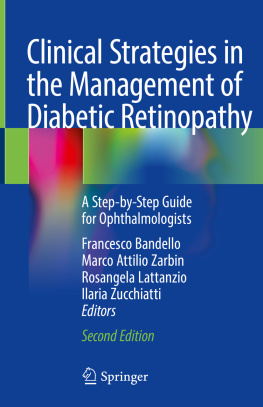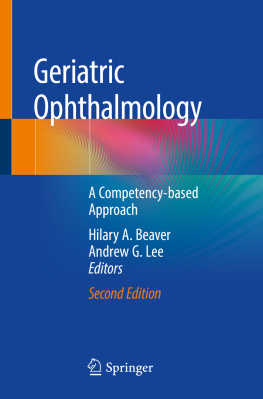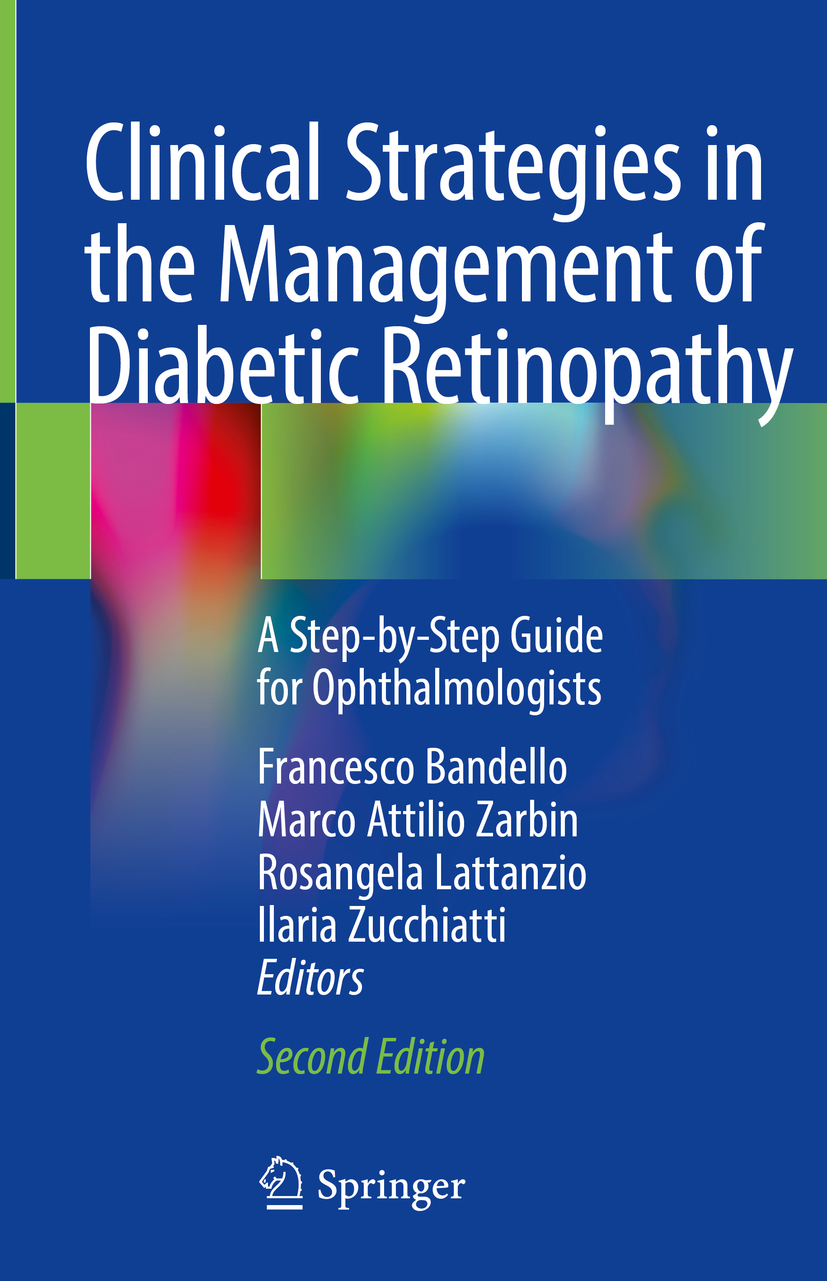Editors
Francesco Bandello , Marco Attilio Zarbin , Rosangela Lattanzio and Ilaria Zucchiatti
Clinical Strategies in the Management of Diabetic Retinopathy A Step-by-Step Guide for Ophthalmologists 2nd ed. 2019
Editors
Francesco Bandello
Department of Ophthalmology, Vita-Salute University, San Raffaele Scientific Institute, Milan, Italy
Marco Attilio Zarbin
Institute of Ophthalmology and Visual Science, Rutgers-New Jersey Medical School, Rutgers University, Newark, NJ, USA
Rosangela Lattanzio
Department of Ophthalmology, Vita-Salute University, San Raffaele Scientific Institute, Milan, Italy
Ilaria Zucchiatti
Department of Ophthalmology, Vita-Salute University, San Raffaele Scientific Institute, Milan, Italy
ISBN 978-3-319-96156-9 e-ISBN 978-3-319-96157-6
https://doi.org/10.1007/978-3-319-96157-6
Library of Congress Control Number: 2018955738
Springer Nature Switzerland AG 2019
This work is subject to copyright. All rights are reserved by the Publisher, whether the whole or part of the material is concerned, specifically the rights of translation, reprinting, reuse of illustrations, recitation, broadcasting, reproduction on microfilms or in any other physical way, and transmission or information storage and retrieval, electronic adaptation, computer software, or by similar or dissimilar methodology now known or hereafter developed.
The use of general descriptive names, registered names, trademarks, service marks, etc. in this publication does not imply, even in the absence of a specific statement, that such names are exempt from the relevant protective laws and regulations and therefore free for general use.
The publisher, the authors, and the editors are safe to assume that the advice and information in this book are believed to be true and accurate at the date of publication. Neither the publisher nor the authors or the editors give a warranty, express or implied, with respect to the material contained herein or for any errors or omissions that may have been made. The publisher remains neutral with regard to jurisdictional claims in published maps and institutional affiliations.
This Springer imprint is published by the registered company Springer Nature Switzerland AG
The registered company address is: Gewerbestrasse 11, 6330 Cham, Switzerland
This book is dedicated to Professor Rosario Brancato, who was a master and a pioneer in the field of diabetic retinopathy diagnosis and treatment.
Foreword
A new era in the management of diabetic retinopathy has started, offering for the first time recovery of visual acuity compared to previous treatments, such as laser photocoagulation, which aimed at disease stabilization. New evidence emerging from randomized clinical trials showed the effectiveness of intravitreal treatment with anti-vascular endothelium growth factor antibodies and steroids in the management of diabetic retinopathy. Moreover, combined treatment strategies and new surgical techniques to date play a significant role, especially in more complicated cases. In addition, the recently introduced diagnostic imaging, such as optical coherence tomography angiography and ultra-wide field angiography, has critically changed our understanding of the pathophysiology of this disease, helping physicians choose the most appropriate treatment.
However, in this new environment of recently approved treatments and new promising therapeutic strategies, clinicians are faced with difficult decisions to choose the appropriate practice in each individual case.
The purpose of this practical guide is to assist ophthalmologists in making decisions in the management of diabetic retinopathy. This richly illustrated manual is based on the best evidence available and provides the practical and complete recommendations to guide clinicians in the management of diabetic retinopathy, including diagnosis, decision-making, and treatment.
This book is designed to address all the different and complex stages of diabetic retinopathy starting from the early stages up to the more advanced and sight-threatening levels of the disease.
The publication also provides new insights into the management and surgical approach of diabetic retinopathy, providing more updated techniques to fight this serious eye disease.
The chapters of this manual have many practical tables and easy-to-read summaries that explain the progression of the disease and help the clinician to choose the best therapeutic approach. Moreover, the manual is enriched by multiple algorithms that describe the suggested treatment approach, helping ophthalmologists in the difficult task of making treatment decisions.
The text is supplemented by almost 100 illustrations, which contain in some of the cases a further follow-up. Several clinical cases are presented through multipart figures that represent the evolution from baseline to final follow-up of the clinical features of eyes that have been treated with the more recently introduced drugs and surgeries. The case reports run in parallel with the text, showing practical examples of the effects of the treatment described in the text.
Clinical Strategies in the Management of Diabetic Retinopathy: Step-by-Step Guide for Ophthalmologists examines all stages of diabetic retinopathy to provide the latest developments in diagnosis and treatment of this severe disease.
I believe that this contribution is timely and will be appreciated by anyone that is faced on a day-to-day basis with the management of diabetic patients with retinal disease.
Jos Cunha-Vaz
Coimbra, Portugal
Preface
Diabetic retinopathy remains the leading cause of visual impairment among the working-age population throughout the world. Diabetic retinopathy is present in approximately one-third of patients with diabetes mellitus, and approximately one-third of patients with diabetic retinopathy have vision-threatening retinopathy, i.e., diabetic macular edema (DME), severe nonproliferative diabetic retinopathy (NPDR), or proliferative diabetic retinopathy (PDR). There is evidence that visual loss could be reduced substantially by strict glycometabolic and effective blood pressure control. Nevertheless, diabetic macular edema and proliferative diabetic retinopathy currently remain major sight-threatening complications, which require prompt, effective treatment.
For nearly a half century, focal laser photocoagulation was the only scientifically proven effective treatment to prevent visual loss due to DME, and panretinal photocoagulation (PRP) was the mainstay of treatment of PDR. Recently, intravitreal treatment with anti-vascular endothelium growth factor (anti-VEGF) antibodies and steroids has revolutionized the management of diabetic retinopathy. Anti-VEGF antibodies, for example, induce regression of diabetic retinopathy and are approved for this therapeutic indication. In addition, anti-VEGF antibodies provide superior visual outcomes in the treatment of DME compared to focal laser photocoagulation. The main advantage of the intravitreal injections compared to focal laser photocoagulation is the chance not only to prevent visual decline but also to promote visual recovery. Finally, in randomized trials, intravitreal anti-VEGF agents provide superior visual outcomes compared to PRP with less loss of peripheral visual field sensitivity, less chance of developing macular edema during treatment, and better average visual acuity during the course of treatment of PDR. Combination therapy involving intravitreal anti-VEGF injection and laser photocoagulation recently has been considered a promising strategy to improve the results further. In some cases of DME and advanced PDR, surgical intervention with pars plana vitrectomy and membrane peeling remains an important treatment option. Of course, the practical application of these trial results is complex and involves issues of patient compliance, cost of treatment, and consideration of the patients overall health status. The goal of this book is to assist the reader in applying the results of randomized clinical trials and extensive personal clinical experience to the complexities inherent to daily clinical practice.













